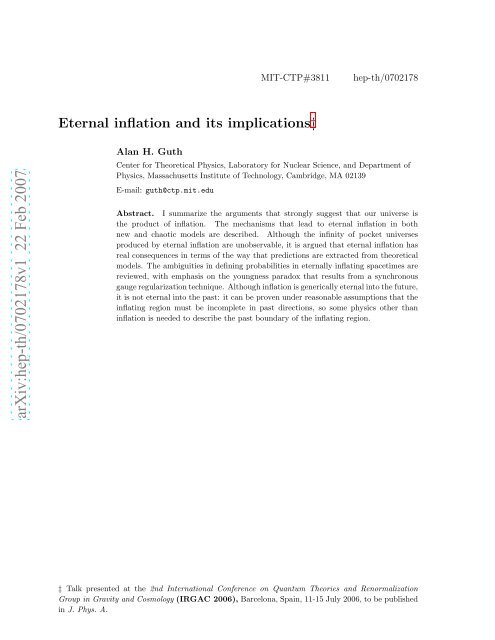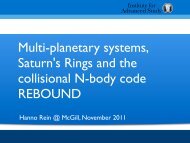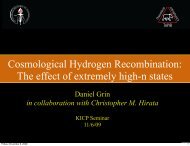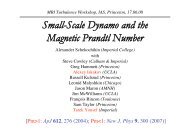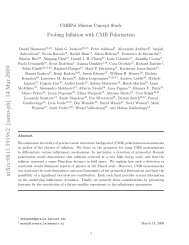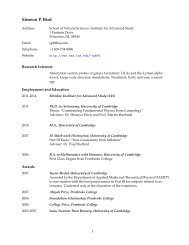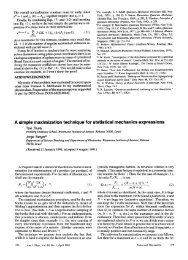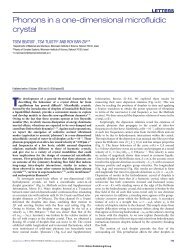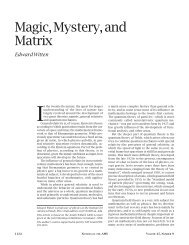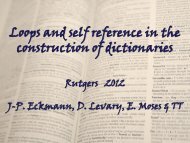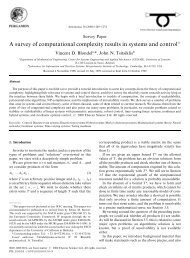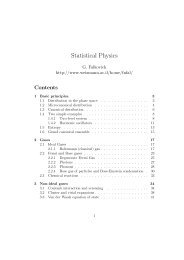Eternal inflation and its implications
Eternal inflation and its implications
Eternal inflation and its implications
Create successful ePaper yourself
Turn your PDF publications into a flip-book with our unique Google optimized e-Paper software.
MIT-CTP#3811<br />
hep-th/0702178<br />
<strong>Eternal</strong> <strong>inflation</strong> <strong>and</strong> <strong>its</strong> <strong>implications</strong>‡<br />
arXiv:hep-th/0702178v1 22 Feb 2007<br />
Alan H. Guth<br />
Center for Theoretical Physics, Laboratory for Nuclear Science, <strong>and</strong> Department of<br />
Physics, Massachusetts Institute of Technology, Cambridge, MA 02139<br />
E-mail: guth@ctp.mit.edu<br />
Abstract. I summarize the arguments that strongly suggest that our universe is<br />
the product of <strong>inflation</strong>. The mechanisms that lead to eternal <strong>inflation</strong> in both<br />
new <strong>and</strong> chaotic models are described. Although the infinity of pocket universes<br />
produced by eternal <strong>inflation</strong> are unobservable, it is argued that eternal <strong>inflation</strong> has<br />
real consequences in terms of the way that predictions are extracted from theoretical<br />
models. The ambiguities in defining probabilities in eternally inflating spacetimes are<br />
reviewed, with emphasis on the youngness paradox that results from a synchronous<br />
gauge regularization technique. Although <strong>inflation</strong> is generically eternal into the future,<br />
it is not eternal into the past: it can be proven under reasonable assumptions that the<br />
inflating region must be incomplete in past directions, so some physics other than<br />
<strong>inflation</strong> is needed to describe the past boundary of the inflating region.<br />
‡ Talk presented at the 2nd International Conference on Quantum Theories <strong>and</strong> Renormalization<br />
Group in Gravity <strong>and</strong> Cosmology (IRGAC 2006), Barcelona, Spain, 11-15 July 2006, to be published<br />
in J. Phys. A.
<strong>Eternal</strong> <strong>inflation</strong> <strong>and</strong> <strong>its</strong> <strong>implications</strong> 2<br />
1. Introduction: the successes of <strong>inflation</strong><br />
Since the proposal of the <strong>inflation</strong>ary model some 25 years ago [1–4], <strong>inflation</strong> has<br />
been remarkably successful in explaining many important qualitative <strong>and</strong> quantitative<br />
properties of the universe. In this article I will summarize the key successes, <strong>and</strong> then<br />
discuss a number of issues associated with the eternal nature of <strong>inflation</strong>. In my opinion,<br />
the evidence that our universe is the result of some form of <strong>inflation</strong> is very solid. Since<br />
the term <strong>inflation</strong> encompasses a wide range of detailed theories, it is hard to imagine<br />
any reasonable alternative. The basic arguments are as follows:<br />
(i) The universe is big<br />
First of all, we know that the universe is incredibly large: the visible part of<br />
the universe contains about 10 90 particles. Since we have all grown up in a large<br />
universe, it is easy to take this fact for granted: of course the universe is big, it’s<br />
the whole universe! In “st<strong>and</strong>ard” FRW cosmology, without <strong>inflation</strong>, one simply<br />
postulates that about 10 90 or more particles were here from the start. However, in<br />
the context of present-day cosmology, many of us hope that even the creation of<br />
the universe can be described in scientific terms. Thus, we are led to at least think<br />
about a theory that might explain how the universe got to be so big. Whatever<br />
that theory is, it has to somehow explain the number of particles, 10 90 or more.<br />
However, it is hard to imagine such a number arising from a calculation in which<br />
the input consists only of geometrical quantities, quantities associated with simple<br />
dynamics, <strong>and</strong> factors of 2 or π. The easiest way by far to get a huge number, with<br />
only modest numbers as input, is for the calculation to involve an exponential. The<br />
exponential expansion of <strong>inflation</strong> reduces the problem of explaining 10 90 particles<br />
to the problem of explaining 60 or 70 e-foldings of <strong>inflation</strong>. In fact, it is easy to<br />
construct underlying particle theories that will give far more than 70 e-foldings of<br />
<strong>inflation</strong>. Inflationary cosmology therefore suggests that, even though the observed<br />
universe is incredibly large, it is only an infinitesimal fraction of the entire universe.<br />
(ii) The Hubble expansion<br />
The Hubble expansion is also easy to take for granted, since we have all known<br />
about it from our earliest readings in cosmology. In st<strong>and</strong>ard FRW cosmology, the<br />
Hubble expansion is part of the list of postulates that define the initial conditions.<br />
But <strong>inflation</strong> actually offers the possibility of explaining how the Hubble expansion<br />
began. The repulsive gravity associated with the false vacuum is just what Hubble<br />
ordered. It is exactly the kind of force needed to propel the universe into a pattern<br />
of motion in which any two particles are moving apart with a velocity proportional<br />
to their separation.<br />
(iii) Homogeneity <strong>and</strong> isotropy<br />
The degree of uniformity in the universe is startling. The intensity of the<br />
cosmic background radiation is the same in all directions, after it is corrected for<br />
the motion of the Earth, to the incredible precision of one part in 100,000. To get
<strong>Eternal</strong> <strong>inflation</strong> <strong>and</strong> <strong>its</strong> <strong>implications</strong> 3<br />
some feeling for how high this precision is, we can imagine a marble that is spherical<br />
to one part in 100,000. The surface of the marble would have to be shaped to an<br />
accuracy of about 1,000 angstroms, a quarter of the wavelength of light.<br />
Although modern technology makes it possible to grind lenses to quarterwavelength<br />
accuracy, we would nonetheless be shocked if we unearthed a stone,<br />
produced by natural processes, that was round to an accuracy of 1,000 angstroms.<br />
If we try to imagine that such a stone were found, I am sure that no one would<br />
accept an explanation of <strong>its</strong> origin which simply proposed that the stone started<br />
out perfectly round. Similarly, I do not think it makes sense to consider any theory<br />
of cosmogenesis that cannot offer some explanation of how the universe became so<br />
incredibly isotropic.<br />
The cosmic background radiation was released about 300,000 years after the<br />
big bang, after the universe cooled enough so that the opaque plasma neutralized<br />
into a transparent gas. The cosmic background radiation photons have mostly<br />
been traveling on straight lines since then, so they provide an image of what the<br />
universe looked like at 300,000 years after the big bang. The observed uniformity of<br />
the radiation therefore implies that the observed universe had become uniform in<br />
temperature by that time. In st<strong>and</strong>ard FRW cosmology, a simple calculation shows<br />
that the uniformity could be established so quickly only if signals could propagate<br />
at 100 times the speed of light, a proposition clearly contradicting the known laws of<br />
physics. In <strong>inflation</strong>ary cosmology, however, the uniformity is easily explained. The<br />
uniformity is created initially on microscopic scales, by normal thermal-equilibrium<br />
processes, <strong>and</strong> then <strong>inflation</strong> takes over <strong>and</strong> stretches the regions of uniformity to<br />
become large enough to encompass the observed universe.<br />
(iv) The flatness problem<br />
I find the flatness problem particularly impressive, because of the extraordinary<br />
numbers that it involves. The problem concerns the value of the ratio<br />
Ω tot ≡ ρ tot<br />
ρ c<br />
, (1)<br />
where ρ tot is the average total mass density of the universe <strong>and</strong> ρ c = 3H 2 /8πG is<br />
the critical density, the density that would make the universe spatially flat. (In the<br />
definition of “total mass density,” I am including the vacuum energy ρ vac = Λ/8πG<br />
associated with the cosmological constant Λ, if it is nonzero.)<br />
By combining data from the Wilkinson Microwave Anisotropy Probe<br />
(WMAP), the Sloan Digital Sky Survey (SDSS), <strong>and</strong> observations of type Ia<br />
supernovae, the authors of Ref. [5] deduced that the present value of Ω tot is equal<br />
to one within a few percent (Ω tot = 1.012 +0.018<br />
−0.022). Although this value is very close<br />
to one, the really stringent constraint comes from extrapolating Ω tot to early times,<br />
since Ω tot = 1 is an unstable equilibrium point of the st<strong>and</strong>ard model evolution.<br />
Thus, if Ω tot was ever exactly equal to one, it would remain exactly one forever.<br />
However, if Ω tot differed slightly from one in the early universe, that difference—<br />
whether positive or negative—would be amplified with time. In particular, it can
<strong>Eternal</strong> <strong>inflation</strong> <strong>and</strong> <strong>its</strong> <strong>implications</strong> 4<br />
be shown that Ω tot − 1 grows as<br />
⎧<br />
⎨t<br />
(during the radiation-dominated era)<br />
Ω tot − 1 ∝<br />
⎩t 2/3 (during the matter-dominated era) .<br />
Dicke <strong>and</strong> Peebles [6] pointed out that at t = 1 second, for example, when the<br />
processes of big bang nucleosynthesis were just beginning, Ω tot must have equaled<br />
one to an accuracy of one part in 10 15 . Classical cosmology provides no explanation<br />
for this fact—it is simply assumed as part of the initial conditions. In the context<br />
of modern particle theory, where we try to push things all the way back to the<br />
Planck time, 10 −43 s, the problem becomes even more extreme. If one specifies the<br />
value of Ω tot at the Planck time, it has to equal one to 59 decimal places in order<br />
to be in the allowed range today.<br />
While this extraordinary flatness of the early universe has no explanation in<br />
classical FRW cosmology, it is a natural prediction for <strong>inflation</strong>ary cosmology.<br />
During the <strong>inflation</strong>ary period, instead of Ω tot being driven away from one as<br />
described by Eq. (2), Ω tot is driven towards one, with exponential swiftness:<br />
Ω tot − 1 ∝ e −2H inft , (3)<br />
where H inf is the Hubble parameter during <strong>inflation</strong>. Thus, as long as there is a<br />
long enough period of <strong>inflation</strong>, Ω tot can start at almost any value, <strong>and</strong> it will be<br />
driven to unity by the exponential expansion.<br />
(v) Absence of magnetic monopoles<br />
All gr<strong>and</strong> unified theories predict that there should be, in the spectrum of<br />
possible particles, extremely massive particles carrying a net magnetic charge. By<br />
combining gr<strong>and</strong> unified theories with classical cosmology without <strong>inflation</strong>, Preskill<br />
[7] found that magnetic monopoles would be produced so copiously that they would<br />
outweigh everything else in the universe by a factor of about 10 12 . A mass density<br />
this large would cause the inferred age of the universe to drop to about 30,000<br />
years! Inflation is certainly the simplest known mechanism to eliminate monopoles<br />
from the visible universe, even though they are still in the spectrum of possible<br />
particles. The monopoles are eliminated simply by arranging the parameters so<br />
that <strong>inflation</strong> takes place after (or during) monopole production, so the monopole<br />
density is diluted to a completely negligible level.<br />
(vi) Anisotropy of the cosmic background radiation<br />
The process of <strong>inflation</strong> smooths the universe essentially completely, but<br />
density fluctuations are generated as <strong>inflation</strong> ends by the quantum fluctuations<br />
of the inflaton field [8, 9]. Generically these are adiabatic Gaussian fluctuations<br />
with a nearly scale-invariant spectrum.<br />
Until recently, astronomers were aware of several cosmological models that<br />
were consistent with the known data: an open universe, with Ω ∼ = 0.3; an<br />
<strong>inflation</strong>ary universe with considerable dark energy (Λ); an <strong>inflation</strong>ary universe<br />
without Λ; <strong>and</strong> a universe in which the primordial perturbations arose from<br />
(2)
<strong>Eternal</strong> <strong>inflation</strong> <strong>and</strong> <strong>its</strong> <strong>implications</strong> 5<br />
Figure 1. Comparison of the latest observational measurements of the temperature<br />
fluctuations in the CMB with several theoretical models, as described in the text. The<br />
temperature pattern on the sky is exp<strong>and</strong>ed in multipoles (i.e., spherical harmonics),<br />
<strong>and</strong> the intensity is plotted as a function of the multipole number l. Roughly speaking,<br />
each multipole l corresponds to ripples with an angular wavelength of 360 ◦ /l.<br />
topological defects such as cosmic strings. Each of these models leads to a distinctive<br />
pattern of resonant oscillations in the early universe, which can be probed today<br />
through <strong>its</strong> imprint on the CMB. As can be seen in Fig. 1 [20], three of the models<br />
are now definitively ruled out. The full class of <strong>inflation</strong>ary models can make a<br />
variety of predictions, but the predictions of the simplest <strong>inflation</strong>ary models with<br />
large Λ, shown on the graph, fit the data beautifully.<br />
2. <strong>Eternal</strong> Inflation: Mechanisms<br />
The remainder of this article will discuss eternal <strong>inflation</strong>—the questions that it can<br />
answer, <strong>and</strong> the questions that it raises. In this section I discuss the mechanisms that<br />
make eternal <strong>inflation</strong> possible, leaving the other issues for the following sections. I will<br />
discuss eternal <strong>inflation</strong> first in the context of new <strong>inflation</strong>, <strong>and</strong> then in the context of<br />
chaotic <strong>inflation</strong>, where it is more subtle.<br />
2.1. <strong>Eternal</strong> New Inflation<br />
The eternal nature of new <strong>inflation</strong> was first discovered by Steinhardt [24], <strong>and</strong> later<br />
that year Vilenkin [25] showed that new <strong>inflation</strong>ary models are generically eternal.
<strong>Eternal</strong> <strong>inflation</strong> <strong>and</strong> <strong>its</strong> <strong>implications</strong> 6<br />
Figure 2. Evolution of the inflaton field during new <strong>inflation</strong>.<br />
Figure 3. A schematic illustration of eternal <strong>inflation</strong>.<br />
Although the false vacuum is a metastable state, the decay of the false vacuum is an<br />
exponential process, very much like the decay of any radioactive or unstable substance.<br />
The probability of finding the inflaton field at the top of the plateau in <strong>its</strong> potential<br />
energy diagram, Fig. 2, does not fall sharply to zero, but instead trails off exponentially<br />
with time [26]. However, unlike a normal radioactive substance, the false vacuum<br />
exponentially exp<strong>and</strong>s at the same time that it decays. In fact, in any successful<br />
<strong>inflation</strong>ary model the rate of exponential expansion is always much faster than the<br />
rate of exponential decay. Therefore, even though the false vacuum is decaying, it<br />
never disappears, <strong>and</strong> in fact the total volume of the false vacuum, once <strong>inflation</strong> starts,<br />
continues to grow exponentially with time, ad infinitum.<br />
Fig. 3 shows a schematic diagram of an eternally inflating universe. The top bar<br />
indicates a region of false vacuum. The evolution of this region is shown by the successive<br />
bars moving downward, except that the expansion could not be shown while still fitting<br />
all the bars on the page. So the region is shown as having a fixed size in comoving<br />
coordinates, while the scale factor, which is not shown, increases from each bar to the<br />
next. As a concrete example, suppose that the scale factor for each bar is three times<br />
larger than for the previous bar. If we follow the region of false vacuum as it evolves from<br />
the situation shown in the top bar to the situation shown in the second bar, in about one
<strong>Eternal</strong> <strong>inflation</strong> <strong>and</strong> <strong>its</strong> <strong>implications</strong> 7<br />
Figure 4. Evolution of the inflaton field during eternal chaotic <strong>inflation</strong>.<br />
third of the region the scalar field rolls down the hill of the potential energy diagram,<br />
precipitating a local big bang that will evolve into something that will eventually appear<br />
to <strong>its</strong> inhabitants as a universe. This local big bang region is shown in gray <strong>and</strong> labelled<br />
“Universe.” Meanwhile, however, the space has exp<strong>and</strong>ed so much that each of the two<br />
remaining regions of false vacuum is the same size as the starting region. Thus, if we<br />
follow the region for another time interval of the same duration, each of these regions of<br />
false vacuum will break up, with about one third of each evolving into a local universe,<br />
as shown on the third bar from the top. Now there are four remaining regions of false<br />
vacuum, <strong>and</strong> again each is as large as the starting region. This process will repeat <strong>its</strong>elf<br />
literally forever, producing a kind of a fractal structure to the universe, resulting in an<br />
infinite number of the local universes shown in gray. There is no st<strong>and</strong>ard name for<br />
these local universes, but they are often called bubble universes. I prefer, however, to<br />
call them pocket universes, to avoid the suggestion that they are round. While bubbles<br />
formed in first-order phase transitions are round [27], the local universes formed in<br />
eternal new <strong>inflation</strong> are generally very irregular, as can be seen for example in the<br />
two-dimensional simulation by Vanchurin, Vilenkin, <strong>and</strong> Winitzki in Fig. 2 of Ref. [28].<br />
The diagram in Fig. 3 is of course an idealization. The real universe is three<br />
dimensional, while the diagram illustrates a schematic one-dimensional universe. It is<br />
also important that the decay of the false vacuum is really a r<strong>and</strong>om process, while<br />
the diagram was constructed to show a very systematic decay, because it is easier to<br />
draw <strong>and</strong> to think about. When these inaccuracies are corrected, we are still left with<br />
a scenario in which <strong>inflation</strong> leads asymptotically to a fractal structure [29] in which<br />
the universe as a whole is populated by pocket universes on arbitrarily small comoving<br />
scales. Of course this fractal structure is entirely on distance scales much too large to<br />
be observed, so we cannot expect astronomers to see it. Nonetheless, one does have<br />
to think about the fractal structure if one wants to underst<strong>and</strong> the very large scale<br />
structure of the spacetime produced by <strong>inflation</strong>.<br />
Most important of all is the simple statement that once <strong>inflation</strong> happens, it<br />
produces not just one universe, but an infinite number of universes.
<strong>Eternal</strong> <strong>inflation</strong> <strong>and</strong> <strong>its</strong> <strong>implications</strong> 8<br />
2.2. <strong>Eternal</strong> Chaotic Inflation:<br />
The eternal nature of new <strong>inflation</strong> depends crucially on the scalar field lingering at the<br />
top of the plateau of Fig. 2. Since the potential function for chaotic <strong>inflation</strong>, Fig. 4, does<br />
not have a plateau, it is not obvious how eternal <strong>inflation</strong> can happen in this context.<br />
Nonetheless, Andrei Linde [30] showed in 1986 that chaotic <strong>inflation</strong> can also be eternal.<br />
In this case <strong>inflation</strong> occurs as the scalar field rolls down a hill of the potential<br />
energy diagram, as in Fig. 4, starting high on the hill. As the field rolls down the hill,<br />
quantum fluctuations will be superimposed on top of the classical motion. The best<br />
way to think about this is to ask what happens during one time interval of duration<br />
∆t = H −1 (one Hubble time), in a region of one Hubble volume H −3 . Suppose that<br />
φ 0 is the average value of φ in this region, at the start of the time interval. By the<br />
definition of a Hubble time, we know how much expansion is going to occur during the<br />
time interval: exactly a factor of e. (This is the only exact number in today’s talk, so I<br />
wanted to emphasize the point.) That means the volume will exp<strong>and</strong> by a factor of e 3 .<br />
One of the deep truths that one learns by working on <strong>inflation</strong> is that e 3 is about equal<br />
to 20, so the volume will exp<strong>and</strong> by a factor of 20. Since correlations typically extend<br />
over about a Hubble length, by the end of one Hubble time, the initial Hubble-sized<br />
region grows <strong>and</strong> breaks up into 20 independent Hubble-sized regions.<br />
As the scalar field is classically rolling down the hill, the change in the field ∆φ<br />
during the time interval ∆t is going to be modified by quantum fluctuations ∆φ qu , which<br />
can drive the field upward or downward relative to the classical trajectory. For any one<br />
of the 20 regions at the end of the time interval, we can describe the change in φ during<br />
the interval by<br />
∆φ = ∆φ cl + ∆φ qu , (4)<br />
where ∆φ cl is the classical value of ∆φ. In lowest order perturbation theory the<br />
fluctuations are calculated using free quantum field, which implies that ∆φ qu , the<br />
quantum fluctuation averaged over one of the 20 Hubble volumes at the end, will have<br />
a Gaussian probability distribution, with a width of order H/2π [13, 31–33]. There is<br />
then always some probability that the sum of the two terms on the right-h<strong>and</strong> side will<br />
be positive — that the scalar field will fluctuate up <strong>and</strong> not down. As long as that<br />
probability is bigger than 1 in 20, then the number of inflating regions with φ ≥ φ 0 will<br />
be larger at the end of the time interval ∆t than it was at the beginning. This process<br />
will then go on forever, so <strong>inflation</strong> will never end.<br />
Thus, the criterion for eternal <strong>inflation</strong> is that the probability for the scalar field<br />
to go up must be bigger than 1/e 3 ≈ 1/20. For a Gaussian probability distribution,<br />
this condition will be met provided that the st<strong>and</strong>ard deviation for ∆φ qu is bigger than<br />
0.61|∆φ cl |. Using ∆φ cl ≈ ˙φ cl H −1 , the criterion becomes<br />
∆φ qu ≈ H 2π > 0.61 | ˙φ cl | H −1 ⇐⇒ H2<br />
| ˙φ cl |<br />
> 3.8 . (5)<br />
We have not discussed the calculation of density perturbations in detail, but the
<strong>Eternal</strong> <strong>inflation</strong> <strong>and</strong> <strong>its</strong> <strong>implications</strong> 9<br />
condition (5) for eternal <strong>inflation</strong> is equivalent to the condition that δρ/ρ on ultra-long<br />
length scales is bigger than a number of order unity.<br />
The probability that ∆φ is positive tends to increase as one considers larger <strong>and</strong><br />
larger values of φ, so sooner or later one reaches the point at which <strong>inflation</strong> becomes<br />
eternal. If one takes, for example, a scalar field with a potential<br />
V (φ) = 1 4 λφ4 , (6)<br />
then the de Sitter space equation of motion in flat Robertson-Walker coordinates takes<br />
the form<br />
¨φ + 3H ˙φ = −λφ 3 , (7)<br />
where spatial derivatives have been neglected. In the “slow-roll” approximation one also<br />
neglects the ¨φ term, so ˙φ ≈ −λφ 3 /(3H), where the Hubble constant H is related to the<br />
energy density by<br />
H 2 = 8π 3 Gρ = 2π 3<br />
λφ 4<br />
M 2 p<br />
. (8)<br />
Putting these relations together, one finds that the criterion for eternal <strong>inflation</strong>, Eq. (5),<br />
becomes<br />
φ > 0.75 λ −1/6 M p . (9)<br />
Since λ must be taken very small, on the order of 10 −12 , for the density perturbations<br />
to have the right magnitude, this value for the field is generally well above the Planck<br />
scale. The corresponding energy density, however, is given by<br />
V (φ) = 1 4 λφ4 = .079λ 1/3 M 4 p , (10)<br />
which is actually far below the Planck scale.<br />
So for these reasons we think <strong>inflation</strong> is almost always eternal. I think the<br />
inevitability of eternal <strong>inflation</strong> in the context of new <strong>inflation</strong> is really unassailable<br />
— I do not see how it could possibly be avoided, assuming that the rolling of the scalar<br />
field off the top of the hill is slow enough to allow <strong>inflation</strong> to be successful. The<br />
argument in the case of chaotic <strong>inflation</strong> is less rigorous, but I still feel confident that it<br />
is essentially correct. For eternal <strong>inflation</strong> to set in, all one needs is that the probability<br />
for the field to increase in a given Hubble-sized volume during a Hubble time interval<br />
is larger than 1/20.<br />
Thus, once <strong>inflation</strong> happens, it produces not just one universe, but an infinite<br />
number of universes.<br />
3. Implications for the L<strong>and</strong>scape of String Theory<br />
Until recently, the idea of eternal <strong>inflation</strong> was viewed by most physicists as an oddity,<br />
of interest only to a small subset of cosmologists who were afraid to deal with concepts<br />
that make real contact with observation. The role of eternal <strong>inflation</strong> in scientific
<strong>Eternal</strong> <strong>inflation</strong> <strong>and</strong> <strong>its</strong> <strong>implications</strong> 10<br />
thinking, however, was greatly boosted by the realization that string theory has no<br />
preferred vacuum, but instead has perhaps 10 1000 [34, 35] metastable vacuum-like states.<br />
<strong>Eternal</strong> <strong>inflation</strong> then has potentially a direct impact on fundamental physics, since it<br />
can provide a mechanism to populate the l<strong>and</strong>scape of string vacua. While all of these<br />
vacua are described by the same fundamental string theory, the apparent laws of physics<br />
at low energies could differ dramatically from one vacuum to another. In particular, the<br />
value of the cosmological constant (e.g., the vacuum energy density) would be expected<br />
to have different values for different vacua.<br />
The combination of the string l<strong>and</strong>scape with eternal <strong>inflation</strong> has in turn led to<br />
a markedly increased interest in anthropic reasoning, since we now have a respectable<br />
set of theoretical ideas that provide a setting for such reasoning. To many physicists,<br />
the new setting for anthropic reasoning is a welcome opportunity: in the multiverse,<br />
life will evolve only in very rare regions where the local laws of physics just happen to<br />
have the properties needed for life, giving a simple explanation for why the observed<br />
universe appears to have just the right properties for the evolution of life. The incredibly<br />
small value of the cosmological constant is a telling example of a feature that seems to<br />
be needed for life, but for which an explanation from fundamental physics is painfully<br />
lacking. Anthropic reasoning can give the illusion of intelligent design [36], without the<br />
need for any intelligent intervention.<br />
On the other h<strong>and</strong>, many other physicists have an abhorrence of anthropic<br />
reasoning. To this group, anthropic reasoning means the end of the hope that precise <strong>and</strong><br />
unique predictions can be made on the basis of logical deduction [37]. Since this hope<br />
should not be given up lightly, many physicists are still trying to find some mechanism<br />
to pick out a unique vacuum from string theory. So far there is no discernable progress.<br />
It seems sensible, to me, to consider anthropic reasoning to be the explanation of<br />
last resort. That is, in the absence of any detailed underst<strong>and</strong>ing of the multiverse,<br />
life, or the evolution of either, anthropic arguments become plausible only when we<br />
cannot find any other explanation. That said, I find it difficult to know whether the<br />
cosmological constant problem is severe enough to justify the explanation of last resort.<br />
Inflation can conceivably help in the search for a nonanthropic explanation of<br />
vacuum selection, since it offers the possibility that only a small minority of vacua are<br />
populated. Inflation is, after all, a complicated mechanism that involves exponentially<br />
large factors in <strong>its</strong> basic description, so it possible that it populates some states<br />
overwhelming more than others. In particular, one might expect that those states that<br />
lead to the fastest exponential expansion rates would be favored. Then these fastest<br />
exp<strong>and</strong>ing states — <strong>and</strong> their decay products — could dominate the multiverse.<br />
But so far, unfortunately, this is only wishful thinking. As I will discuss in the<br />
next section, we do not even know how to define probabilities in eternally inflating<br />
multiverses. Furthermore, it does not seem likely that any principle that favors a rapid<br />
rate of exponential <strong>inflation</strong> will favor a vacuum of the type that we live in. The<br />
key problem, as one might expect, is the value of the cosmological constant. The<br />
cosmological constant Λ in our universe is extremely small, i.e., Λ < ∼ 10 −120 in Planck
<strong>Eternal</strong> <strong>inflation</strong> <strong>and</strong> <strong>its</strong> <strong>implications</strong> 11<br />
un<strong>its</strong>. If <strong>inflation</strong> singles out the state with the fastest exponential expansion rate, the<br />
energy density of that state would be expected to be of order Planck scale or larger. To<br />
explain why our vacuum has such a small energy density, we would need to find some<br />
reason why this very high energy density state should decay preferentially to a state<br />
with an exceptionally small energy density [38].<br />
There has been some effort to find relaxation methods that might pick out the<br />
vacuum [39], <strong>and</strong> perhaps this is the best hope for a nonanthropic explanation of the<br />
cosmological constant. So far, however, the l<strong>and</strong>scape of nonanthropic solutions to this<br />
problem seems bleak.<br />
4. Difficulties in Calculating Probabilities<br />
In an eternally inflating universe, anything that can happen will happen; in fact, it will<br />
happen an infinite number of times. Thus, the question of what is possible becomes<br />
trivial—anything is possible, unless it violates some absolute conservation law. To<br />
extract predictions from the theory, we must therefore learn to distinguish the probable<br />
from the improbable.<br />
However, as soon as one attempts to define probabilities in an eternally inflating<br />
spacetime, one discovers ambiguities. The problem is that the sample space is infinite, in<br />
that an eternally inflating universe produces an infinite number of pocket universes. The<br />
fraction of universes with any particular property is therefore equal to infinity divided<br />
by infinity—a meaningless ratio. To obtain a well-defined answer, one needs to invoke<br />
some method of regularization.<br />
To underst<strong>and</strong> the nature of the problem, it is useful to think about the integers<br />
as a model system with an infinite number of entities. We can ask, for example, what<br />
fraction of the integers are odd. Most people would presumably say that the answer is<br />
1/2, since the integers alternate between odd <strong>and</strong> even. That is, if the string of integers<br />
is truncated after the Nth, then the fraction of odd integers in the string is exactly 1/2<br />
if N is even, <strong>and</strong> is (N + 1)/2N if N is odd. In any case, the fraction approaches 1/2<br />
as N approaches infinity.<br />
However, the ambiguity of the answer can be seen if one imagines other orderings<br />
for the integers. One could, if one wished, order the integers as<br />
1, 3, 2, 5, 7, 4, 9, 11, 6 , . . ., (11)<br />
always writing two odd integers followed by one even integer. This series includes each<br />
integer exactly once, just like the usual sequence (1, 2, 3, 4, . . .). The integers are just<br />
arranged in an unusual order. However, if we truncate the sequence shown in Eq. (11)<br />
after the Nth entry, <strong>and</strong> then take the limit N → ∞, we would conclude that 2/3 of<br />
the integers are odd. Thus, we find that the definition of probability on an infinite set<br />
requires some method of truncation, <strong>and</strong> that the answer can depend nontrivially on<br />
the method that is used.<br />
In the case of eternally inflating spacetimes, the natural choice of truncation might<br />
be to order the pocket universes in the sequence in which they form. However, we
<strong>Eternal</strong> <strong>inflation</strong> <strong>and</strong> <strong>its</strong> <strong>implications</strong> 12<br />
must remember that each pocket universe fills <strong>its</strong> own future light cone, so no pocket<br />
universe forms in the future light cone of another. Any two pocket universes are spacelike<br />
separated from each other, so some observers will see one as forming first, while other<br />
observers will see the opposite. One can arbitrarily choose equal-time surfaces that<br />
foliate the spacetime, <strong>and</strong> then truncate at some value of t, but this recipe is not unique.<br />
In practice, different ways of choosing equal-time surfaces give different results.<br />
5. The Youngness Paradox<br />
If one chooses a truncation in the most naive way, one is led to a set of very peculiar<br />
results which I call the youngness paradox.<br />
Specifically, suppose that one constructs a Robertson-Walker coordinate system<br />
while the model universe is still in the false vacuum (de Sitter) phase, before any pocket<br />
universes have formed. One can then propagate this coordinate system forward with a<br />
synchronous gauge condition,§ <strong>and</strong> one can define probabilities by truncating at a fixed<br />
value t f of the synchronous time coordinate t. That is, the probability of any particular<br />
property can be taken to be proportional to the volume on the t = t f hypersurface which<br />
has that property. This method of defining probabilities was studied in detail by Linde,<br />
Linde, <strong>and</strong> Mezhlumian, in a paper with the memorable title “Do we live in the center<br />
of the world?” [40]. I will refer to probabilities defined in this way as synchronous gauge<br />
probabilities.<br />
The youngness paradox is caused by the fact that the volume of false vacuum is<br />
growing exponentially with time with an extraordinary time constant, in the vicinity of<br />
10 −37 s. Since the rate at which pocket universes form is proportional to the volume of<br />
false vacuum, this rate is increasing exponentially with the same time constant. That<br />
means that in each second the number of pocket universes that exist is multiplied by a<br />
factor of exp {10 37 }. At any given time, therefore, almost all of the pocket universes that<br />
exist are universes that formed very very recently, within the last several time constants.<br />
The population of pocket universes is therefore an incredibly youth-dominated society,<br />
in which the mature universes are vastly outnumbered by universes that have just barely<br />
begun to evolve. Although the mature universes have a larger volume, this multiplicative<br />
factor is of little importance, since in synchronous coordinates the volume no longer<br />
grows exponentially once the pocket universe forms.<br />
Probability calculations in this youth-dominated ensemble lead to peculiar results,<br />
as discussed in Ref. [40]. These authors considered the expected behavior of the mass<br />
density in our vicinity, concluding that we should find ourselves very near the center<br />
of a spherical low-density region. Here I would like to discuss a less physical but<br />
simpler question, just to illustrate the paradoxes associated with synchronous gauge<br />
probabilities. Specifically, I will consider the question: “Are there any other civilizations<br />
§ By a synchronous gauge condition, I mean that each equal-time hypersurface is obtained by<br />
propagating every point on the previous hypersurface by a fixed infinitesimal time interval ∆t in the<br />
direction normal to the hypersurface.
<strong>Eternal</strong> <strong>inflation</strong> <strong>and</strong> <strong>its</strong> <strong>implications</strong> 13<br />
in the visible universe that are more advanced than ours?”. Intuitively I would not<br />
expect <strong>inflation</strong> to make any predictions about this question, but I will argue that the<br />
synchronous gauge probability distribution strongly implies that there is no civilization<br />
in the visible universe more advanced than us.<br />
Suppose that we have reached some level of advancement, <strong>and</strong> suppose that t min<br />
represents the minimum amount of time needed for a civilization as advanced as we are<br />
to evolve, starting from the moment of the decay of the false vacuum—the start of the<br />
big bang. The reader might object on the grounds that there are many possible measures<br />
of advancement, but I would respond by inviting the reader to pick any measure she<br />
chooses; the argument that I am about to give should apply to all of them. The reader<br />
might alternatively claim that there is no sharp minimum t min , but instead we should<br />
describe the problem in terms of a function which gives the probability that, for any<br />
given pocket universe, a civilization as advanced as we are would develop by time t. I<br />
believe, however, that the introduction of such a probability distribution would merely<br />
complicate the argument, without changing the result. So, for simplicity of discussion,<br />
I will assume that there is some sharply defined minimum time t min required for a<br />
civilization as advanced as ours to develop.<br />
Since we exist, our pocket universe must have an age t 0 satisfying<br />
t 0 ≥ t min . (12)<br />
Suppose, however, that there is some civilization in our pocket universe that is more<br />
advanced than we are, let us say by 1 second. In that case Eq. (12) is not sufficient, but<br />
instead the age of our pocket universe would have to satisfy<br />
t 0 ≥ t min + 1 second . (13)<br />
However, in the synchronous gauge probability distribution, universes that satisfy<br />
Eq. (13) are outnumbered by universes that satisfy Eq. (12) by a factor of approximately<br />
exp {10 37 }. Thus, if we know only that we are living in a pocket universe that satisfies<br />
Eq. (12), it is extremely improbable that it also satisfies Eq. (13). We would conclude,<br />
therefore, that it is extraordinarily improbable that there is a civilization in our pocket<br />
universe that is at least 1 second more advanced than we are.<br />
Perhaps this argument explains why SETI has not found any signals from alien<br />
civilizations, but I find it more plausible that it is merely a symptom that the<br />
synchronous gauge probability distribution is not the right one.<br />
Although the problem of defining probabilities in eternally inflating universe has<br />
not been solved, a great deal of progress has been made in exploring options <strong>and</strong><br />
underst<strong>and</strong>ing their properties. For many years Vilenkin <strong>and</strong> his collaborators [28, 41]<br />
were almost the only cosmologists working on this issue, but now the field is growing<br />
rapidly [42].
<strong>Eternal</strong> <strong>inflation</strong> <strong>and</strong> <strong>its</strong> <strong>implications</strong> 14<br />
6. Does Inflation Need a Beginning?<br />
If the universe can be eternal into the future, is it possible that it is also eternal into<br />
the past? Here I will describe a recent theorem [43] which shows, under plausible<br />
assumptions, that the answer to this question is no.‖<br />
The theorem is based on the well-known fact that the momentum of an object<br />
traveling on a geodesic through an exp<strong>and</strong>ing universe is redshifted, just as the<br />
momentum of a photon is redshifted. Suppose, therefore, we consider a timelike or null<br />
geodesic extended backwards, into the past. In an exp<strong>and</strong>ing universe such a geodesic<br />
will be blueshifted. The theorem shows that under some circumstances the blueshift<br />
reaches infinite rapidity (i.e., the speed of light) in a finite amount of proper time (or<br />
affine parameter) along the trajectory, showing that such a trajectory is (geodesically)<br />
incomplete.<br />
To describe the theorem in detail, we need to quantify what we mean by an<br />
exp<strong>and</strong>ing universe. We imagine an observer whom we follow backwards in time along<br />
a timelike or null geodesic. The goal is to define a local Hubble parameter along this<br />
geodesic, which must be well-defined even if the spacetime is neither homogeneous nor<br />
isotropic. Call the velocity of the geodesic observer v µ (τ), where τ is the proper time<br />
in the case of a timelike observer, or an affine parameter in the case of a null observer.<br />
(Although we are imagining that we are following the trajectory backwards in time,<br />
τ is defined to increase in the future timelike direction, as usual.) To define H, we<br />
must imagine that the vicinity of the observer is filled with “comoving test particles,”<br />
so that there is a test particle velocity u µ (τ) assigned to each point τ along the geodesic<br />
trajectory, as shown in Fig. 5. These particles need not be real — all that will be<br />
necessary is that the worldlines can be defined, <strong>and</strong> that each worldline should have<br />
zero proper acceleration at the instant it intercepts the geodesic observer.<br />
To define the Hubble parameter that the observer measures at time τ, the observer<br />
focuses on two particles, one that he passes at time τ, <strong>and</strong> one at τ + ∆τ, where in the<br />
end he takes the limit ∆τ → 0. The Hubble parameter is defined by<br />
H ≡ ∆v radial<br />
, (14)<br />
∆r<br />
where ∆v radial is the radial component of the relative velocity between the two particles,<br />
<strong>and</strong> ∆r is their distance, where both quantities are computed in the rest frame of one of<br />
the test particles, not in the rest frame of the observer. Note that this definition reduces<br />
to the usual one if it is applied to a homogeneous isotropic universe.<br />
The relative velocity between the observer <strong>and</strong> the test particles can be measured<br />
by the invariant dot product,<br />
γ ≡ u µ v µ , (15)<br />
‖ There were also earlier theorems about this issue by Borde <strong>and</strong> Vilenkin (1994, 1996) [44, 45], <strong>and</strong><br />
Borde [46] (1994), but these theorems relied on the weak energy condition, which for a perfect fluid<br />
is equivalent to the condition ρ + p ≥ 0. This condition holds classically for forms of matter that<br />
are known or commonly discussed as theoretical proposals. It can, however, be violated by quantum<br />
fluctuations [47], <strong>and</strong> so the applicability of these theorems is questionable.
<strong>Eternal</strong> <strong>inflation</strong> <strong>and</strong> <strong>its</strong> <strong>implications</strong> 15<br />
Figure 5. An observer measures the velocity of passing test particles to infer the<br />
Hubble parameter.<br />
which for the case of a timelike observer is equal to the usual special relativity Lorentz<br />
factor<br />
1<br />
γ = √ . (16)<br />
1 − vrel<br />
2<br />
If H is positive we would expect γ to decrease with τ, since we expect the observer’s<br />
momentum relative to the test particles to redshift. It turns out, however, that the<br />
relationship between H <strong>and</strong> changes in γ can be made precise. If one defines<br />
⎧<br />
⎨ 1/γ for null observers<br />
F(γ) ≡<br />
(17)<br />
⎩ arctanh(1/γ) for timelike observers ,<br />
then<br />
H = dF(γ) . (18)<br />
dτ<br />
I like to call F(γ) the “slowness” of the geodesic observer, because it increases as<br />
the observer slows down, relative to the test particles. The slowness decreases as we<br />
follow the geodesic backwards in time, but it is positive definite, <strong>and</strong> therefore cannot<br />
decrease below zero. F(γ) = 0 corresponds to γ = ∞, or a relative velocity equal to<br />
that of light. This bound allows us to place a rigorous limit on the integral of Eq. (18).<br />
For timelike geodesics,<br />
∫ ( )<br />
τf<br />
1<br />
(√ )<br />
H dτ ≤ arctanh = arctanh 1 − vrel<br />
2 , (19)<br />
γ f<br />
where γ f is the value of γ at the final time τ = τ f . For null observers, if we normalize<br />
the affine parameter τ by dτ/dt = 1 at the final time τ f , then<br />
∫ τf<br />
H dτ ≤ 1 . (20)<br />
Thus, if we assume an averaged expansion condition, i.e., that the average value of the<br />
Hubble parameter H av along the geodesic is positive, then the proper length (or affine<br />
length for null trajectories) of the backwards-going geodesic is bounded. Thus the region<br />
for which H av > 0 is past-incomplete.
<strong>Eternal</strong> <strong>inflation</strong> <strong>and</strong> <strong>its</strong> <strong>implications</strong> 16<br />
It is difficult to apply this theorem to general <strong>inflation</strong>ary models, since there is no<br />
accepted definition of what exactly defines this class. However, in st<strong>and</strong>ard eternally<br />
inflating models, the future of any point in the inflating region can be described by a<br />
stochastic model [48] for inflaton evolution, valid until the end of <strong>inflation</strong>. Except for<br />
extremely rare large quantum fluctuations, H > ∼<br />
√<br />
(8π/3)Gρf , where ρ f is the energy<br />
density of the false vacuum driving the <strong>inflation</strong>. The past for an arbitrary model is less<br />
certain, but we consider eternal models for which the past is like the future. In that<br />
case H would be positive almost everywhere in the past inflating region. If, however,<br />
H av > 0 when averaged over a past-directed geodesic, our theorem implies that the<br />
geodesic is incomplete.<br />
There is of course no conclusion that an eternally inflating model must have a<br />
unique beginning, <strong>and</strong> no conclusion that there is an upper bound on the length of<br />
all backwards-going geodesics from a given point. There may be models with regions<br />
of contraction embedded within the exp<strong>and</strong>ing region that could evade our theorem.<br />
Aguirre <strong>and</strong> [49, 50] have proposed a model that evades our theorem, in which the<br />
arrow of time reverses at the t = −∞ hypersurface, so the universe “exp<strong>and</strong>s” in both<br />
halves of the full de Sitter space.<br />
The theorem does show, however, that an eternally inflating model of the type<br />
usually assumed, which would lead to H av > 0 for past-directed geodesics, cannot<br />
be complete. Some new physics (i.e., not <strong>inflation</strong>) would be needed to describe the<br />
past boundary of the inflating region. One possibility would be some kind of quantum<br />
creation event.<br />
One particular application of the theory is the cyclic ekpyrotic model of Steinhardt<br />
& Turok [51]. This model has H av > 0 for null geodesics for a single cycle, <strong>and</strong> since<br />
every cycle is identical, H av > 0 when averaged over all cycles. The cyclic model is<br />
therefore past-incomplete, <strong>and</strong> requires a boundary condition in the past.<br />
7. Conclusion<br />
In this paper I have summarized the arguments that strongly suggest that our universe<br />
is the product of <strong>inflation</strong>. I argued that <strong>inflation</strong> can explain the size, the Hubble<br />
expansion, the homogeneity, the isotropy, <strong>and</strong> the flatness of our universe, as well as<br />
the absence of magnetic monopoles, <strong>and</strong> even the characteristics of the nonuniformities.<br />
The detailed observations of the cosmic background radiation anisotropies continue to<br />
fall in line with <strong>inflation</strong>ary expectations, <strong>and</strong> the evidence for an accelerating universe<br />
f<strong>its</strong> beautifully with the <strong>inflation</strong>ary preference for a flat universe. Our current picture<br />
of the universe seems strange, with 95% of the energy in forms of matter that we do not<br />
underst<strong>and</strong>, but nonetheless the picture f<strong>its</strong> together extraordinarily well.<br />
Next I turned to the question of eternal <strong>inflation</strong>, claiming that essentially all<br />
<strong>inflation</strong>ary models are eternal. In my opinion this makes <strong>inflation</strong> very robust: if it<br />
starts anywhere, at any time in all of eternity, it produces an infinite number of pocket<br />
universes. A crucial issue in our underst<strong>and</strong>ing of fundamental physics is the selection
REFERENCES 17<br />
of the vacuum, which according to current ideas in string theory could be any one of<br />
a colossal number of possibilities. <strong>Eternal</strong> <strong>inflation</strong> offers at least a hope that a small<br />
set of vacua might be strongly favored. For that reason it is important for us to learn<br />
more about the evolution of the multiverse during eternal <strong>inflation</strong>. But so far it is only<br />
wishful thinking to suppose that eternal <strong>inflation</strong> will allow us to determine the vacuum<br />
in which we should expect to find ourselves.<br />
I then discussed the past of eternally inflating models, concluding that under mild<br />
assumptions the inflating region must have a past boundary, <strong>and</strong> that new physics (other<br />
than <strong>inflation</strong>) is needed to describe what happens at this boundary.<br />
Although eternal <strong>inflation</strong> has fascinating consequences, our underst<strong>and</strong>ing of it<br />
remains incomplete. In particular, we still do not underst<strong>and</strong> how to define probabilities<br />
in an eternally inflating spacetime.<br />
We should keep in mind, however, that observations in the past few years have<br />
vastly improved our knowledge of the early universe, <strong>and</strong> that these new observations<br />
have been generally consistent with the simplest <strong>inflation</strong>ary models. It is the success<br />
of these predictions that justifies spending time on the more speculative aspects of<br />
<strong>inflation</strong>ary cosmology.<br />
Acknowledgments<br />
This work is supported in part by funds provided by the U.S. Department of Energy<br />
(D.O.E.) under grant #DF-FC02-94ER40818. The author would particularly like to<br />
thank Joan Sola <strong>and</strong> his group at the University of Barcelona, who made the IRGAC-<br />
2006 conference so valuable <strong>and</strong> so enjoyable.<br />
References<br />
[1] Guth, A H 1981 “The <strong>inflation</strong>ary universe: A possible solution to the horizon <strong>and</strong><br />
flatness problems,” Phys. Rev. D 23, 347–356.<br />
[2] Linde, A D 1982 “A new <strong>inflation</strong>ary universe scenario: a possible solution of the<br />
horizon, flatness, homogeneity, isotropy <strong>and</strong> primordial monopole problems,” Phys.<br />
Lett. B 108, 389–93.<br />
[3] Albrecht, A <strong>and</strong> Steinhardt, P J 1982 “Cosmology for gr<strong>and</strong> unified theories with<br />
radiatively induced symmetry breaking,” Phys. Rev. Lett. 48, 1220–3.<br />
[4] For an earlier example of an <strong>inflation</strong>ary model with a completely different<br />
motivation, see Starobinsky, A A 1979 Zh. Eksp. Teor. Fiz. 30, 719 [JETP Lett. 30,<br />
682 (1979)]; Starobinsky, A A 1980 “A new type of isotropic cosmological models<br />
without singularity,” Phys. Lett. B 91, 99–102.<br />
[5] M. Tegmark et al. 2004 “Cosmological parameters from SDSS <strong>and</strong> WMAP,” Phys.<br />
Rev. D 69, 103501 [arXiv:astro-ph/0310723].
REFERENCES 18<br />
[6] Dicke, R H <strong>and</strong> Peebles, P J E 1979, in General Relativity: An Einstein Centenary<br />
Survey, eds: Hawking, S W <strong>and</strong> Israel, W (Cambridge: Cambridge University<br />
Press).<br />
[7] Preskill, J P 1979 “Cosmological production of superheavy magnetic monopoles,”<br />
Phys. Rev. Lett. 43, 1365–8.<br />
[8] The history of this subject has become a bit controversial, so I’ll describe my<br />
best underst<strong>and</strong>ing of the situation. The idea that quantum fluctuations could be<br />
responsible for the large scale structure of the universe goes back at least as far<br />
as Sakharov’s 1965 paper [10], <strong>and</strong> it was re-introduced in the modern context by<br />
Mukhanov <strong>and</strong> Chibisov [11, 12], who considered the density perturbations arising<br />
during <strong>inflation</strong> of the Starobinsky [4] type. The calculations for “new” <strong>inflation</strong>,<br />
including a description of the evolution of the perturbations through “horizon exit,”<br />
reheating, <strong>and</strong> “horizon reentry,” were first carried out in a series of papers [13–16]<br />
arising from the Nuffield Workshop in Cambridge, UK, in 1982. For Starobinsky<br />
<strong>inflation</strong>, the evolution of the conformally flat perturbations during <strong>inflation</strong> (as<br />
described in Ref. [12]) into the post-<strong>inflation</strong> nonconformal perturbations was<br />
calculated, for example, in Refs. [17] <strong>and</strong> [18]. For a different perspective, the<br />
reader should see Ref. [19].<br />
[9] For modern reviews, see for example Dodelson, S 2003 Modern Cosmology (San<br />
Diego, CA: Academic Press); Liddle, A R <strong>and</strong> Lyth, D H 2000 Cosmological<br />
Inflation <strong>and</strong> Large-Scale Structure (Cambridge: Cambridge University Press);<br />
Mukhanov, V F, Feldman, H A <strong>and</strong> Br<strong>and</strong>enberger, R H 1992 “Theory of<br />
cosmological perturbations,” Phys. Rept. 215, 203–333.<br />
[10] Sakharov, A. D. 1965 “The initial stage of an exp<strong>and</strong>ing universe <strong>and</strong> the<br />
appearance of a nonuniform distribution of matter,” Zh. Eksp. Teor. Fiz. 49, 345<br />
[JETP Lett. 22, 241-9, 1966].<br />
[11] Mukhanov, V. F. <strong>and</strong> Chibisov, G. V. 1981 “Quantum fluctuations <strong>and</strong> a<br />
nonsingular universe,” Pis’ma Zh. Eksp. Teor. Fiz. 33, 549–53 [JETP Lett. 33,<br />
532–5 (1981)].<br />
[12] Mukhanov, V. F. & Chibisov, G. V. 1982 “Vacuum energy <strong>and</strong> large-scale structure<br />
of the universe,” Zh. Eksp. Teor. Fiz. 83, 475–87 [JETP Lett. 56, 258–65 (1982)].<br />
[13] Starobinsky, A A 1982 “Dynamics of phase transition in the new <strong>inflation</strong>ary<br />
universe scenario <strong>and</strong> generation of perturbations,” Phys. Lett. B 117, 175–8.<br />
[14] Guth, A H <strong>and</strong> Pi, S-Y 1982 “Fluctuations in the new <strong>inflation</strong>ary universe,” Phys.<br />
Rev. Lett. 49, 1110–3.<br />
[15] Hawking, S W 1982 “The development of irregularities in a single bubble<br />
<strong>inflation</strong>ary universe,” Phys. Lett. B 115, 295–7.<br />
[16] Bardeen, J M, Steinhardt, P J <strong>and</strong> Turner, M S 1983 “Spontaneous creation of<br />
almost scale-free density perturbations in an <strong>inflation</strong>ary universe,” Phys. Rev. D<br />
28, 679–93.
REFERENCES 19<br />
[17] Starobinsky, A A 1983 “The perturbation spectrum evolving from a nonsingular,<br />
initially de Sitter cosmology, <strong>and</strong> the microwave background anisotropy,” Pis’ma<br />
Astron. Zh. 9, 579–84 [Sov. Astron. Lett. 9, 302–4 (1983)].<br />
[18] Mukhanov, V F 1989 “Quantum theory of cosmological perturbations in R 2<br />
gravity,” Phys. Lett. B 218, 17–20.<br />
[19] Mukhanov, V F 2003 “CMB, quantum fluctuations <strong>and</strong> the predictive power of<br />
<strong>inflation</strong>,” arXiv:astro-ph/03030779.<br />
[20] I thank Max Tegmark for providing this graph, an earlier version of which appeared<br />
in Ref. [21]. The graph shows the most precise data points for each range of l<br />
from recent observations, as summarized in Refs. [5] <strong>and</strong> [22]. The cosmic string<br />
prediction is taken from Ref. [23], <strong>and</strong> the “Inflation with Λ” curve was calculated<br />
from the best-fit parameters to the WMAP 3-year data from Table 5 of Ref. [22].<br />
The other curves were both calculated for n s = 1, Ω baryon = 0.05, <strong>and</strong> H = 70<br />
km s −1 Mpc −1 , with the remaining parameters fixed as follows. “Inflation without<br />
Λ”: Ω DM = 0.95, Ω Λ = 0, τ = 0.06; “Open universe”: Ω DM = 0.25, Ω Λ = 0,<br />
τ = 0.06. With our current ignorance of the underlying physics, none of these<br />
theories predicts the overall amplitude of the fluctuations; the “Inflation with Λ”<br />
curve was normalized for a best fit, <strong>and</strong> the others were normalized arbitrarily.<br />
[21] Guth, A H <strong>and</strong> Kaiser, D I 2005 “Inflationary cosmology: Exploring the universe<br />
from the smallest to the largest scales,” Science 307, 884–90 [arXiv:astroph/0502328].<br />
[22] Spergel, D N et al. 2006 “Wilkinson Microwave Anisotropy Probe (WMAP) three<br />
year results: Implications for cosmology,” arXiv:astro-ph/0603449.<br />
[23] Pen, U.-L., Seljak, U <strong>and</strong> Turok, N 1997 “Power spectra in global defect theories of<br />
cosmic structure formation,” Phys. Rev. Lett. 79, 1611 [arXiv:astro-ph/9704165].<br />
[24] Steinhardt, P J 1983 “Natural <strong>inflation</strong>,” in The Very Early Universe, Proceedings<br />
of the Nuffield Workshop, Cambridge, 21 June – 9 July, 1982, eds: Gibbons, G<br />
W, Hawking, S W <strong>and</strong> Siklos, S T C (Cambridge: Cambridge University Press),<br />
pp. 251–66.<br />
[25] Vilenkin, A 1983 “The birth of <strong>inflation</strong>ary universes,” Phys. Rev. D 27, 2848–55.<br />
[26] Guth, A H <strong>and</strong> Pi, S-Y “Quantum mechanics of the scalar field in the new<br />
<strong>inflation</strong>ary universe,” Phys. Rev. D 32, 1899–1920.<br />
[27] Coleman, S <strong>and</strong> De Luccia, F 1980 “Gravitational effects on <strong>and</strong> of vacuum decay,”<br />
Phys. Rev. D 21, 3305–15.<br />
[28] Vanchurin, V, Vilenkin, A <strong>and</strong> Winitzki, S 2000 “Predictability crisis in <strong>inflation</strong>ary<br />
cosmology <strong>and</strong> <strong>its</strong> resolution,” Phys. Rev. D 61, 083507 [arXiv:gr-qc/9905097].<br />
[29] Aryal, M <strong>and</strong> Vilenkin, A 1987 “The fractal dimension of <strong>inflation</strong>ary universe,”<br />
Phys. Lett. B 199, 351–7.<br />
[30] Linde, A D 1986 “<strong>Eternal</strong> chaotic <strong>inflation</strong>,” Mod. Phys. Lett. A 1, 81-5; Linde,<br />
A D 1986 “<strong>Eternal</strong>ly existing selfreproducing chaotic <strong>inflation</strong>ary universe,” Phys.
REFERENCES 20<br />
Lett. B 175, 395–400; Goncharov, A S, Linde, A D <strong>and</strong> Mukhanov, V F 1987 “The<br />
global structure of the <strong>inflation</strong>ary universe,” Int. J. Mod. Phys. A 2, 561–91.<br />
[31] Vilenkin, A <strong>and</strong> Ford, L H 1982 “Gravitational effects upon cosmological phase<br />
transitions,” Phys. Rev. D 26, 1231–41.<br />
[32] Linde, A D 1982 “Scalar field fluctuations in exp<strong>and</strong>ing universe <strong>and</strong> the new<br />
<strong>inflation</strong>ary universe scenario,” Phys. Lett. B 116, 335.<br />
[33] Starobinsky, A 1986 in Field Theory, Quantum Gravity <strong>and</strong> Strings, eds: de Vega, H<br />
J <strong>and</strong> Sánchez, N, Lecture Notes in Physics (Springer Verlag) Vol. 246, pp. 107–26.<br />
[34] Bousso, R <strong>and</strong> Polchinski, J 2000 “Quantization of four form fluxes <strong>and</strong><br />
dynamical neutralization of the cosmological constant,” J. High Energy Phys.<br />
JHEP06(2000)006 [arXiv:hep-th/0004134].<br />
[35] Susskind, L 2003 “The anthropic l<strong>and</strong>scape of string theory,” arXiv:hepth/0302219.<br />
[36] Susskind, L 2006 The Cosmic L<strong>and</strong>scape: String theory <strong>and</strong> the illusion of<br />
intelligent design (New York: Little, Brown <strong>and</strong> Company).<br />
[37] See, for example, Gross, D J 2005 “Where do we st<strong>and</strong> in fundamental string<br />
theory,” Phys. Scripta T 117, 102–5; Gross, D 2005 “The future of physics,” Int.<br />
J. Mod. Phys. A 20, 5897-909.<br />
[38] I thank Joseph Polchinski for convincing me of this point.<br />
[39] See, for example, Abbott, L F 1985 “A mechanism for reducing the value of the<br />
cosmological constant,” Phys. Lett. B 150, 427; Feng, J L, March-Russell, J,<br />
Sethi, S <strong>and</strong> Wilczek, F 2001 “Saltatory relaxation of the cosmological constant,”<br />
Nucl. Phys. B 602, 307–28 [arXiv:hep-th/0005276]; Steinhardt, P J <strong>and</strong> Turok, N<br />
2006 “Why the cosmological constant is small <strong>and</strong> positive,” Science 312, 1180-2<br />
[arXiv:astro-ph/0605173] <strong>and</strong> references therein.<br />
[40] Linde, A D, Linde, D <strong>and</strong> Mezhlumian, A 1995 “Do we live in the center of the<br />
world?” Phys. Lett. B 345, 203–10 [arXiv:hep-th/9411111].<br />
[41] Vilenkin, A 1998 “Unambiguous probabilities in an eternally inflating universe,”<br />
Phys. Rev. Lett. 81, 5501–4 [arXiv:hep-th/9806185]; Garriga, J <strong>and</strong> Vilenkin, A<br />
2001 “A prescription for probabilities in eternal <strong>inflation</strong>,” Phys. Rev. D 64, 023507<br />
[arXiv:gr-qc/0102090]; Garriga, J, Schwartz-Perlov, D, Vilenkin, A <strong>and</strong> Winitzki,<br />
S 2006 “Probabilities in the <strong>inflation</strong>ary multiverse,” J. Cosmol. Astropart. Phys.<br />
JCAP01(2006)017 [arXiv:hep-th/0509184].<br />
[42] Tegmark, M 2005 “What does <strong>inflation</strong> really predict?” J. Cosmol. Astropart.<br />
Phys. JCAP 04(2005)001 [arXiv:astro-ph/0410281]; Easther, R, Lim, E A <strong>and</strong><br />
Martin, M R 2006 “Counting pockets with world lines in eternal <strong>inflation</strong>,” J.<br />
Cosmol. Astropart. Phys. JCAP 03(2006)016 [arXiv:astro-ph/0511233]; Bousso, R,<br />
Freivogel, B <strong>and</strong> Lippert, M 2006 “Probabilities in the l<strong>and</strong>scape: The decay of<br />
nearly flat space,” Phys. Rev. D 74, 046008 [arXiv:hep-th/0603105]; Bousso, R<br />
2006 “Holographic probabilities in eternal <strong>inflation</strong>,” Phys. Rev. Lett. 97, 191302
REFERENCES 21<br />
[arXiv:hep-th/0605263]; Aguirre, A, Gratton, S <strong>and</strong> Johnson, M C 2006 “Measures<br />
on transitions for cosmology in the l<strong>and</strong>scape,” arXiv:hep-th/0612195.<br />
[43] Borde, A, Guth, A H <strong>and</strong> Vilenkin, A 2003 “Inflationary spacetimes are incomplete<br />
in past directions,” Phys. Rev. Lett. 90, 151301 [arXiv:gr-qc/0110012].<br />
[44] Borde, A <strong>and</strong> Vilenkin, A 1994 “<strong>Eternal</strong> <strong>inflation</strong> <strong>and</strong> the initial singularity,” Phys.<br />
Rev. Lett. 72, 3305–9 [arXiv:gr-qc/9312022].<br />
[45] Borde, A <strong>and</strong> Vilenkin, A 1996 “Singularities in <strong>inflation</strong>ary cosmology: A review,”<br />
Talk given at 6th Quantum Gravity Seminar, Moscow, Russia, 6-11 Jun 1996, Int.<br />
J. Mod. Phys. D 5, 813–24 [arXiv:gr-qc/9612036].<br />
[46] Borde, A 1994 “Open <strong>and</strong> closed universes, initial singularities <strong>and</strong> <strong>inflation</strong>,” Phys.<br />
Rev. D 50, 3692–702 [arXiv:gr-qc/9403049].<br />
[47] Borde, A <strong>and</strong> Vilenkin, A 1997 “Violations of the weak energy condition in inflating<br />
spacetimes,” Phys. Rev. D 56, 717–23 [arXiv:gr-qc/9702019].<br />
[48] Goncharov, A S, Linde, A D <strong>and</strong> Mukhanov, V F 1987 “The global structure of<br />
the <strong>inflation</strong>ary universe,” Int. J. Mod. Phys. A 2, 561–91.<br />
[49] Aguirre, A <strong>and</strong> Gratton, S 2002 “Steady state eternal <strong>inflation</strong>,” Phys. Rev. D 65,<br />
083507 [arXiv:astro-ph/0111191].<br />
[50] Aguirre, A <strong>and</strong> Gratton, S 2003 “Inflation without a beginning: A null boundary<br />
proposal,” Phys. Rev. D 67, 083515 [arXiv:gr-qc/0301042].<br />
[51] Steinhardt, P J <strong>and</strong> Turok, N G 2002 “Cosmic evolution in a cyclic universe,” Phys.<br />
Rev. D 65, 126003 [arXiv:hep-th/0111098].


